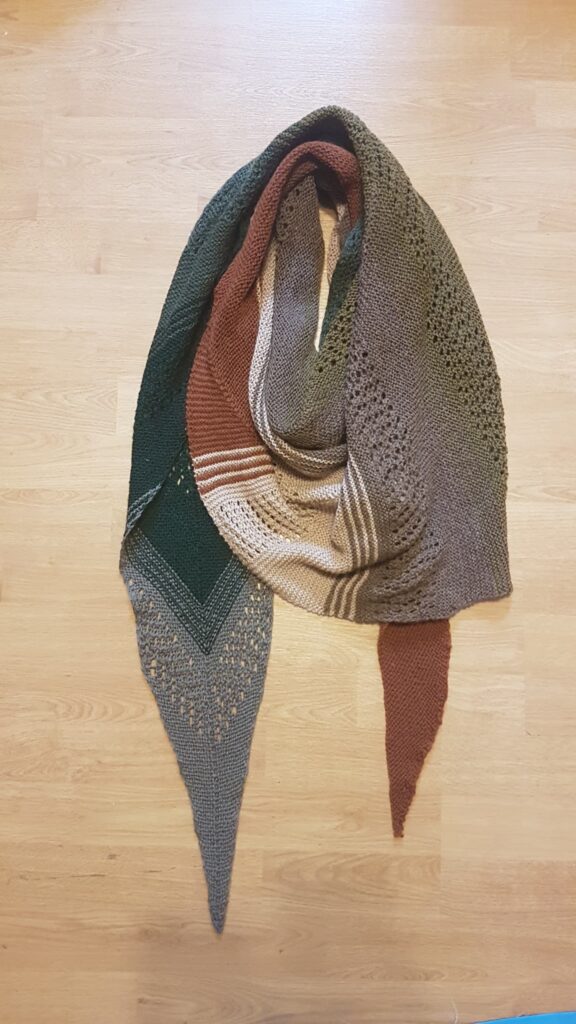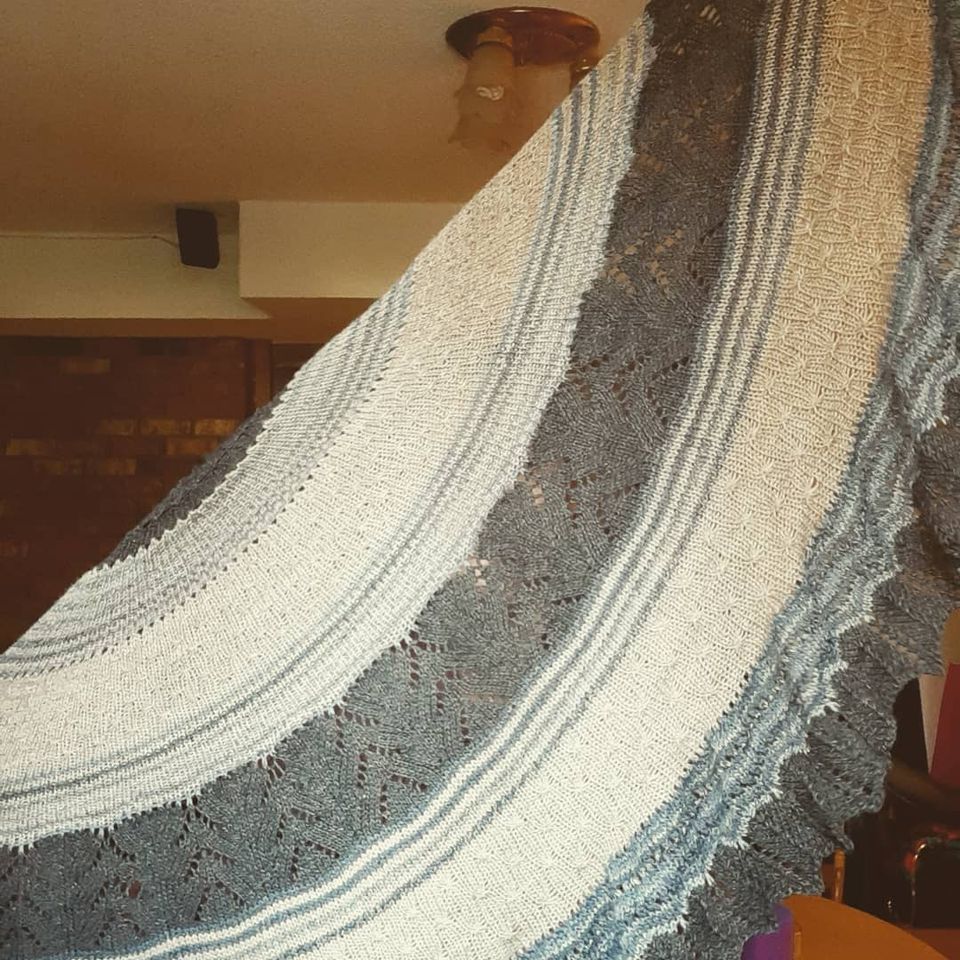My metaphor for teaching is a knitting.
Knitting requires a lot of time, patience, attention to detail, and dedication. A few things that I love about knitting, is no matter what you do, each stitch is unique; and is essential to the whole; and there are endless opportunities of what you can make given a yarn and some knitting needles.
This metaphor represents my views on teaching careers and the diversity that we see in the classroom, in which the students can be seen as the stitches or the knitters later in the posts.

If we start looking at knitting to represent the core values of teaching career theory… we can think about if we think about knitting a project, has anyone ever dropped a stitch? What do you do?
Do you take advantage of this the hole and it now becomes a design feature of the shawl?
Do you toss the project in the garbage?
Do you pull out the whole project apart?
Or do you find a way to fix it?
This can be a great representation of the values that I think we need to teach our students in career.
We want them to learn how to plan, but also how to be adaptable (aka fixing the dropped stitch or taking advantage of that dropped stitch). If there is one thing for certain, is that life isn’t going to work out perfectly along a path that was planned in high school. I mean personally, I thought I was going to be a dentist since I was in elementary school, but it wasn’t until I had gotten an interview that I realized that it wasn’t going to be able to make me happy.
So, I want students to apply the idea of happenstance, where we take advantage of the random occurrences and opportunities that occur in each student life and find a way to apply that to their goals, plans or future trajectories to get them to where they want to go (Krumboltz, 2008).
I also want them to build the gumption, and resilience to learn from mistakes, work hard to overcome challenges, and all the while build the skills that are going to help them deal with problem easier in the future (Truyens, 2019).
Lastly, the idea of using the skills we are building now to better ourselves in the future. For example, learning fix the whole in our knitting or using our skills we already have in a new way. In terms or careers, we do not know what kind of jobs are going to available in the future so planning for it is nearly impossible, but what we can do is build up skills or transformative competencies that are transferable. Then use these skills to allow you to grow and fill that roll in the future (OECD, n.d.).
Overall, giving students the skills so that they can plan, adapt, and take responsibility for their future.
I think that my metaphor can also help us look at diversity in the classroom
Visioning each student in the class as a stitch in a project, like in the shawl below.
- Each stitch is unique, just like in the picture, some have different colors, some are lace stitches, some are textured, but each one contributes an essential component to the scarf.
- Just like in our classroom each student is going to have a different background, cultures, personality, socio economic status, academic ability, strengths, weaknesses, and exceptionalities.
- But each one of those makes our students unique and different, meaning that they are going to have something different, to bring to the classroom, need support within the classroom, and desire to take way from the classroom than myself in high school, and what I originally planned. Which is why we need to be flexible in our practice.
A quote from the textbook that really outlined the importance of including diversity into the planning practices is “We begin our planning with all students in mind and with the conviction that our planning for a full range of learner strengths and styles means that more students will have opportunities to be successful more of the time, and that fewer adaptations and modifications will be required for students with special needs” (Brownlie, Fullerton, and Schnellert 2011, p3.).
I think that this highlights why we need to use universal design for learning, allowing a low floor and high ceiling, so that no matter the ability, there is an entry point into the learning, and all students can feel included in the classroom. Rather that having to create several different projects and assignments to create a fair learning experience.
I feel like my learning and growth from this block aligns with the First People’s Principles of Learning.
“Learning is holistic”
- In order to prepare a lesson that is going to be useful for our students, we need to think and plan holistically. Taking into account and providing space for all students to be able to be their whole selves including the physical, mental social, emotional, and spiritual selves (Chrona, 2016).
- If we don’t make room and accept the whole of who our students are, then I think we are going to get only a part of their efforts reflected in their work. You need that reciprocal respect and value.
“Learning quires exploration of one’s identity”
- Students need to learn who they are, their strengths weaknesses and skills in order to help understand their own needs and supports, but also to figure out where they fit in the present and in their future careers (Chrona, 2016).
Impact of Blocks 4 and 5 on my pedagogy
Before these two summer blocks, I feel like my pedagogy was centered around a few philosophical beliefs including constructivism, humanism, and progressivism.
So, I as a teacher I valued the idea that we need to build our knowledge and understanding through active processing and social interactions; that we need our basic needs met in order to actually focus on learning and school; and learning happens at a different rate and in a specific way for each child, so we need to focus on them.
However, my pedagogy also felt hollow in a way because I felt like I had the shell values, but not quite the skills or methods yet to really implement them.
Where am I at now after the summer blocks?
- I feel like I am figuring out how to fill in those missing implementations.
- From My diversity and inclusion and curriculum and instruction have laid out how I can plan to create learning experiences that are accessible through UDL, clear expectation, co-created criteria, and implementation of adaptations and supports to create an equitable child centered learning environment.
- From Curriculum and instruction, and Innovative community-based approaches I found the importance of inquiry, story, and hand on learning to engage students and allow them the space to personalize their learning. While at the same time utilizing the skills to that are going to translate to the workplace later in life and making this that translation transparent.
- From careers – I have learned the importance of the class as an underlying theme through any course. Rather than only being taught in its own class. The cross-curricular links to careers allows for students to see the real-world relevance in terms of the skills that they are building and help them students see the broad world outside of high school, and the connections of courses to jobs around the word.
References
Brownline, F., Fullerton, C., & Schnellert, L. (2011). It’s All About Thinking: Collaborating to Support All Learners in Mathmatics and Science. Winnipeg: Portage & Main Press.
Chrona, J. (2016, April). First Peoples Principles of Learning. Retrieved from First Peoples Principles of Learning: https://firstpeoplesprinciplesoflearning.wordpress.com/
Krumboltz, J. (2008). The Happenstance Learning Theory. SAGE Journals, 135-154.
OECD. (n.d.). OECD Future of Education and Skills 2030. Retrieved from OECD Better Policies for Better Lives: https://www.oecd.org/education/2030-project/
Truyens, M. (2019). Coherent Career Practice. Retrieved from MARCR: Career Professionals: https://marcr.net/marcr-for-career-professionals/career-theory/career-theories-and-theorists/coherent-career-practice-kris-magnusson-dave-redekopp/

Leave a Reply